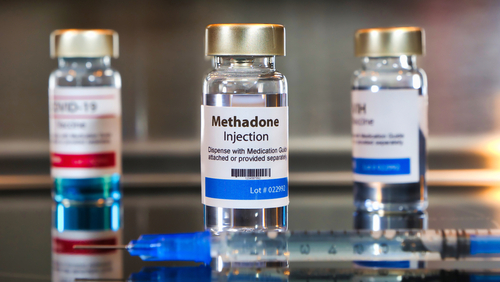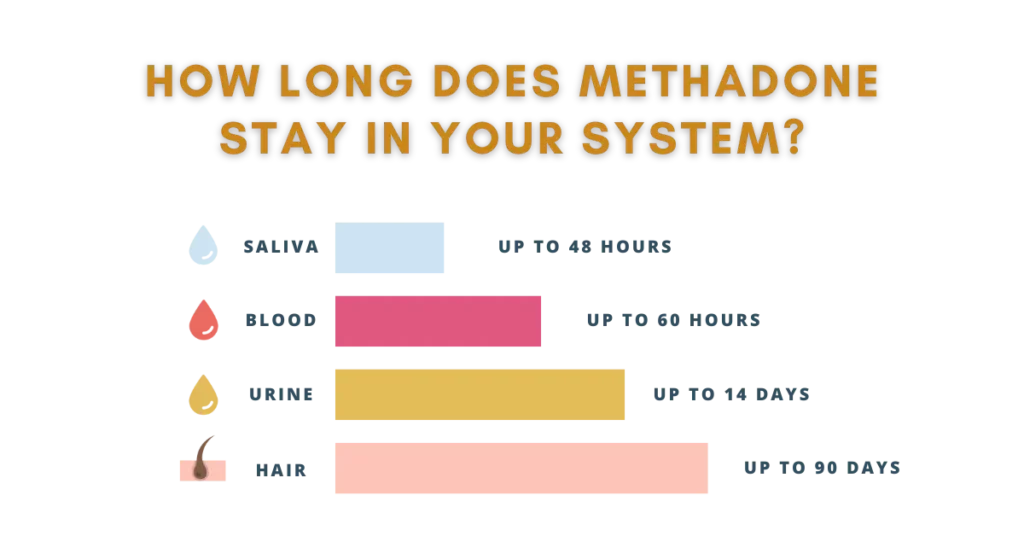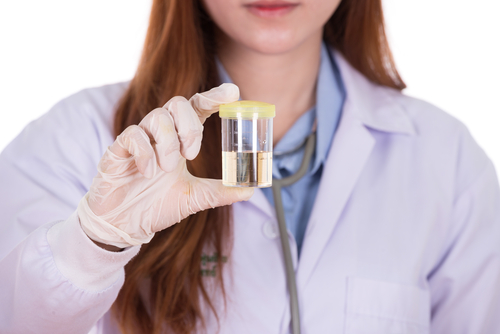How Long Does Methadone Stay In Your System? Detox & More
Methadone is commonly used for pain management and as a common part of opioid addiction treatment programs. As individuals go through the addiction treatment process, they may begin to wonder: “How long does methadone stay in your system?” Understanding the timeline of methadone’s presence in the system is essential for medical professionals, individuals undergoing treatment, employers conducting drug tests, and those seeking insights into methadone’s effects.
In this article, we will gain an understanding of methadone, its side effects, how long methadone stays in the body, and how to eliminate methadone from the body.

What Is Methadone?
Methadone is a synthetic opioid used to treat opioid addiction for a more extended period compared to other medications. It affects the brain and nervous system’s response to pain, blocking withdrawal symptoms and euphoric effects, called medication-assisted treatment (MAT), and allowing individuals to focus on their recovery without disruptions. MAT, combined with therapy and support groups, forms a comprehensive addiction treatment program. The usual treatment duration is about one year before considering tapering off methadone.
When used in addiction recovery, methadone is a well-researched and effective treatment that helps people avoid heroin and other opioids. Methadone is commonly prescribed due to its cost-effectiveness compared to other painkillers. According to the Substance Abuse and Mental Health Services Administration (SAMHSA), the reported number of individuals using methadone for opioid treatment reached 350,000 in 2015. This showcases the rise of methadone use in opioid addiction, and its number of uses continues to rise.
Side Effects of Methadone
Methadone, like any medication, can cause various side effects. While many people tolerate it well, some individuals may experience negative reactions that can be potentially life-threatening. However, it’s essential to understand the potential side effects when using methadone for pain management or addiction treatment so that you can receive proper treatment. Some of the most common side effects of methadone include:
- Nausea or vomiting
- Constipation
- Drowsiness or fatigue
- Dry mouth
- Sweating
- Mood swings
- Fluid retention
- Respiratory depression

How Long Does Methadone Stay In Your System?
Methadone can stay in your system for various amounts of time depending on age, weight, metabolism, liver function, and any existing health conditions. Additionally, how long individuals have been taking methadone, how often they use it, the dosage amount, and if they use other substances alongside it all affect how quickly their body processes methadone.
When detecting if methadone is in your system, specific tests are utilized. These include urine, saliva, hair, and blood tests, each with varying detection time windows. The detection window for these tests is:
- Urine Tests: These are the most common and preferred methods for methadone testing. They can detect methadone in the system from one hour to up to two weeks after the last dose. Urine tests are noninvasive, easy to administer, relatively inexpensive, and have a long detection period.
- Saliva Tests: These offer a convenient and noninvasive way to detect methadone use. Traces of methadone can be found in saliva within 30 minutes after ingestion and can remain detectable for up to two days after the last use.
- Hair Tests: Hair tests help detect long-term methadone use. People with a history of regular methadone use will have traces of it in their hair. For those who have just started taking methadone, it might take a couple of weeks for methadone to show up in the hair. Traces of methadone can remain in the hair for up to 90 days after the last use.
- Blood Tests: Methadone can be detected in the blood within 30 minutes of the last use and remains detectable for around 60 hours. While blood tests are highly accurate, they are expensive, invasive, and have a relatively short detection window. Therefore, they are the least commonly used test for methadone detection.

Can Methadone Cause a Failed Drug Test?
Typically, methadone is cleared from your system within two weeks. However, it can still be detectable for a longer time, depending on the type of drug test used. Various organizations, such as employers, addiction treatment programs, athletic groups, and law enforcement, may request methadone drug tests. Standard drug tests can detect opioids like heroin, codeine, and morphine, but they do not identify methadone use. If an individual regularly uses methadone, they may wonder if methadone can cause a failed drug test.
Methadone itself can cause a failed drug test if it is not a part of the substances being tested for. To identify methadone use, a more specialized drug test is required, which focuses on its unique chemical makeup. It’s worth noting that certain over-the-counter medications can sometimes lead to a false positive result for methadone. For instance, Diphenhydramine, found in common antihistamines like Benadryl, may occasionally appear as methadone in a drug test. However, when undergoing a drug test, you must communicate any medications you are taking to avoid misunderstandings.

How Can You Eliminate Methadone From Your System?
Since methadone is a long-lasting medication, it can take some time to eliminate methadone from your system entirely. When trying to eliminate methadone, it is vital to recognize the potential risks of withdrawing from methadone. Before discussing withdrawal symptoms, let’s explore how an individual may eliminate methadone from their system. Some of the most common ways to get rid of methadone include the following:
- Gradual Tapering: If you have been using methadone for pain management or opioid addiction treatment, working with a healthcare professional to develop a tapering plan is essential. Gradually reducing the dosage over time can help your body adjust and minimize withdrawal symptoms.
- Detox: Some individuals may choose to undergo a methadone detoxification program under medical supervision. These programs provide a supportive environment while gradually reducing the methadone dosage, similar to tapering.
- Lifestyle Changes: Maintaining a healthy lifestyle can aid in the elimination process. Regular exercise, a balanced diet, and staying well-hydrated can support your body’s natural detoxification processes.
- Professional Help: Going through the methadone elimination process can be physically and emotionally challenging. Seeking support from healthcare professionals, support groups, or counseling can be beneficial during this time. Individuals may seek out treatment programs at addiction treatment centers to receive this help.
Methadone Withdrawal Symptoms
Methadone withdrawal occurs when someone who has been using methadone for pain management or opioid addiction treatment reduces their dosage or stops taking the medication. Withdrawal symptoms can be challenging to endure, but they are a natural part of the body readjusting to the absence of methadone. It is important to note that all individuals can experience varying symptoms depending on factors such as the individual’s history of methadone use, the dosage they were on, and how they taper off the medication. Some of the most common withdrawal symptoms of methadone are:
- Anxiety
- Cravings
- Restlessness
- Sweating
- Depression
- Nausea or vomiting
- Muscle pain
Opioid Addiction Treatment Near You
As methadone is used to treat opioid addiction, it can be a valuable tool in treatment programs. Utilizing methadone is a form of medication-assisted treatment, a viable treatment option to assist individuals in their recovery journey. By incorporating this medication into a treatment plan, individuals have a chance of recovering from opioid addiction and other substance use disorders.
At Oasis Recovery Center, we provide our clients with holistic, comprehensive, and individualized addiction treatment through dynamic and evidence-based therapies. Our center treats all kinds of substance abuse and utilizes the Oasis Recovery Model to ensure we address every aspect of addiction.
If you or a loved one are struggling with opioid addiction, methadone addiction, or any other kind of drug addiction, contact us today to learn more about our programs.









